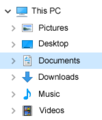File management
TDF LibreOffice Document Liberation Project Community Blogs Weblate Nextcloud Redmine Ask LibreOffice Donate
Foreword
The video shows how file management can be done under LibreOffice and links to this page here for more information and details.
This description refers to the version LibreOffice under Windows 10 and 11.
Link to the video
Link to the video:
File management for LibreOffice - on Windows
File management for LibreOffice on Windows


Are you an user?
The person registered on the PC is also referred to as a user.
There is a personal folder structure for each user account, some of which already exist automatically.
What is "file management"?
The word "file management" consists of "file" and "management".
What exactly does "file" mean?
For the user, files on the computer are usually documents, photos, videos or music.
For example, files are used in programs such as the text program "Writer".
When you have finished editing a file, you should save it.
What exactly does "management" mean?
The management of the files is similar to that in an office.
In the office there are folders in a cupboard and the folders contain documents.
Label these folders so that you can find your documents again.
The principle on the PC is analogous.
There are storage media in the PC on which folders for files can be created.
-
Mass Storage Device
-
Principel data
-
User Folder Structure
Where are the files stored?
For example, files are stored on the hard drive or SSD (Mass Storage Device) in the computer.
When it comes to data on the PC, a basic distinction is made between
"Operating system", "Programs", "Own data" and "Others" (Principel data).
You are dealing with "Own data" here
Many files accumulate over time.
To keep the overview, use the folder structure and adapt it.
How can I organize my files?
The folder structure already available to users in the Windows 10 operating system consists of at least the "Pictures", "Documents", "Music", "Videos" and "Downloads" folders.
Here the user can create their own subfolders at will.
In the case of Writer files, deal with the "Documents" folder.
In Writer you can access your files with the menu options or .
Or you open the file explorer to reach your files.
To do this, click on the "Start" icon ![]() in the task bar of the PC and then on "File Explorer"
in the task bar of the PC and then on "File Explorer" ![]() .
.
Or you press the key combination ⊞ Win + E.
You will now create new folders under the "Documents" folder
Start File Explorer and left-click on the "Documents" folder.
Click the "New Folder" icon to create a new folder.
Enter the name "Letters" for the new folder.
Press the ↵ Enter key.
The new folder "Letters" has now been created.
Below the "Letters" folder, create two more folders
Select the "Letters" folder.
Click the "New Folder" icon to create a new folder.
Enter the name "Letters out" for the new folder.
Press the ↵ Enter key.
Select the "Letters" folder again.
Click the "New Folder" icon to create a new folder.
Enter the name "Letters in" for the new folder.
Press the ↵ Enter key.
You will now change the names of the two subfolders
First select the "Letters out" folder and right-click on it and select .
Place the cursor behind "out" and conclude with "going" and press the ↵ Enter key.
Then select the "Letters in" folder and right-click on it and select .
Place the cursor behind "in" and conclude with "coming" and press the ↵ Enter key.
The "Letters" folder now contains the two subfolders "Letters incoming" and "Letters outgoing".
These subfolders are still empty.
10 files were placed in the "Letters outgoing" folder.
You can download the files from these site: Used working documents
You will now mark and copy the files
Left click on the top file.
Hold down the ⇧ Shift key and click on the third file from the top.
If you now hold the Ctrl key, you can mark additional files.
Click on the white area in the file explorer, the markings will be removed.
If you hold down the Ctrl key, the incoming files are marked.
Right-click on the last highlighted file and click .
Right-click the "Letters incoming" folder and click .
You have now positioned the incoming letters by cutting and pasting them in the correct folder.
Copy a file
To do this, right-click on the file.
Click on in the menu.
Right-click on the "Letters outgoing" folder and select .
The "Letters_03 incoming" file is now located in the "Letters incoming " and "Letters outgoing" folders.
Delete a file
Now delete the "Letters_03 incoming" file.
Right-click the file and choose .
File names under Windows (from 95)
Structure
- File name
- Dot
- File name extension (also called file suffix or file extension, usually consists of three characters)
File extensions are assigned to specific applications under Windows (file assignment).
Example: MyFileOne-Name.odt
File extensions in LibreOffice
LibreOffice works with the Open Document Format (ODF).
The files saved by the components therefore all start in the extension with the characters ODx (x = the component).
For the components:
- Writer = ODT
- Calc = ODS
- Impress = ODP
- Draw = ODG
- Math = ODF
- Base = ODB
However, many alien formats are also permitted.
Illegal characters in file names
/ \ : * ? " < > |
Problematic characters in file names
&
File names in Wikipedia
Further informations
Used working documents
The working documents can be downloaded here:
Documentation / Manuals
Here you will find the Documentation / Manuals:
Any questions?
For questions on this topic go to:
Get Involved
Join us today and help us to make it even better!
Donate
LibreOffice is Free Software and is made available free of charge.
Your donation, which is purely optional, supports our worldwide community.
If you like the software, please consider a Donation.
